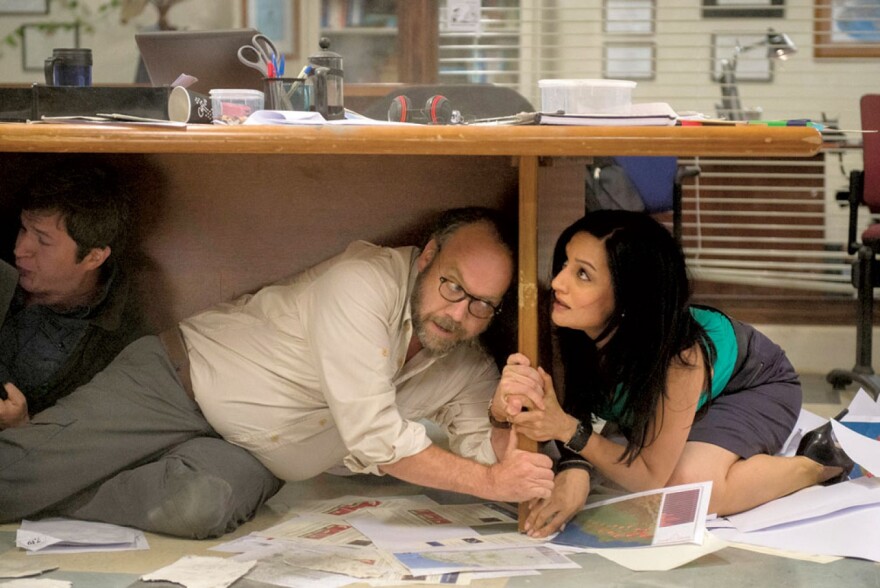This archival content was originally written for and published on KPCC.org. Keep in mind that links and images may no longer work — and references may be outdated.
Shake Out: 6 steps to quake-proof your home

Every third Thursday of October, Californians drop, cover and hold on to practice for the day a big earthquake hits the state.
Chances are many of us will be at home when the big one comes. Be they ever so humble, our homes are full of potentially dangerous hazards in the event of a quake.
A study found that most people hospitalized after the magnitude 6.7 Northridge quake in 1994 were injured by falls or flying objects in their home.
Securing your house takes time, but you don't have to do it all at once. Here are some tips to get you started.
1. Know Your "Safe Spaces"
A "safe space" is the place you should head to the second you feel shaking. It should be a table or desk with a durable, solid top (no glass!).
Crawl under with your knees on the ground. Crouch down to protect your vital organs and hold on to the legs of the desk or table so it doesn't bounce away.
(Always drop cover and hold on in an earthquake. Image via Great California ShakeOut.)
Try to identify a safe place in every room, said quake preparedness guru Margaret Vinci of Caltech’s Seismological Laboratory.
That way you won't be running across the house when shaking starts.
"The less movement you make the less you are apt to get hurt," Vinci said.
Beds, by the way, make terrible safe places she noted, because they are hard to crouch under and can be thrown up in the air and land hard on anyone under them.
If you are in a room with no good safe place, Vinci recommends heading to an interior corner away from glass and crouching down.
2. Putty the Small Stuff
During an earthquake your home will become a firing range for object not bolted down, says Vinci.
Smaller tchotchkes can be held in place with stuff known as museum putty or earthquake putty.
It's easy to apply and remove, so you can use it on object you might want to display for a while and store later.
Puttying a prized item could save it from smashing during a quake, so putty is especially important for family heirlooms.
3. Strap the Big Stuff
Large objects can also be tossed across a room in a strong quake, Vinci said.
That happened last year during the South Napa earthquake when a woman was killed after a TV hit her in the head.
To minimize the risk from larger objects, you should bolt things in place or strap them down, said Vinci.
For instance, a TV can be strapped to a stud in the wall or strapped to the furniture it sits on and then that can be strapped to the wall. The same goes for bookshelves, lamps, end tables, ovens and water heaters.
Don't forget to make sure your refrigerator is secure too. Vinci said during the Northridge quake, some fridges moved great distances.
"Refrigerators went all the way out the walls and into the street," she said.
(Straps can keep large piece of furniture from falling over. Image via QuakeHOLD)
4. Latches are Key
Don't expect cabinets to stay closed in an earthquake.
Glass and heavy objects in cupboards will likely fall out and smash on the floor.
A simple solution is to use baby proofing latches on cabinet doors. This is especially crucial if the items are above knee level where they could hit someone's head.
You can also use hooks for paintings that latch closed, so that cherished artwork doesn't fly off the wall.
5. You Gotta Keep 'Em Separated
One threat many of us might overlook are cleaning supplies.
After a quake, your soaps and sprays could end up on the floor. If products containing ammonia combine with products containing bleach, toxic fumes will rise.
"So know what is under your sink," Vinci said. "Don’t keep chemicals together that if they are combined together they become a deadly chemical."
6. Don't Throw Sparks
If you have a gas stove, there is a chance your oven will come loose in a quake and leak fumes.
April Kelcy, founder of safety consulting company Earthquake Solutions, said this can create a problem since most modern homes are airtight to be energy efficient.
"If someone hits a light switch or if they use an ordinary utility flashlight, which can throw a spark, you could have a problem if you had accumulated fumes in the house," she said.
For this same reason, Kelcy said, NEVER use a candle after an earthquake.
Kelcy says you should have spark-free flashlight near your bed so you can have access to light immediately after a quake. There are several brands that fit the bill.
If all of this is overwhelming to you, that's okay Vinci said.
"People have to realize, it’s not something you do over night," she said. "It’s something you have to start and it’s a process."
Vinci said if you secure a few things every once in a while, your home will soon become a much safer place.
Correction: An earlier version of this story erroneously reported that the Shake Out takes place every October 15. It's every third Thursday of the month.
